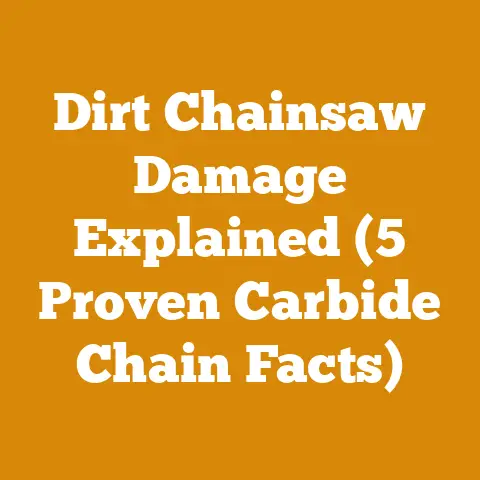Husqvarna 455 Rancher Brake Assembly Tips (5 Pro Fixes)
The sharp, acrid tang of bar oil hangs in the air, mingling with the sweet, earthy scent of freshly cut wood.
The whirring symphony of a well-tuned chainsaw, typically a source of satisfaction, can quickly turn sour when something goes wrong.
And few things are as frustrating – and potentially dangerous – as a malfunctioning chain brake.
I’ve spent years felling trees, bucking logs, and splitting wood, and I’ve learned firsthand the importance of a reliable chain brake.
It’s not just a safety feature; it’s your lifeline.
Today, we’re diving deep into the Husqvarna 455 Rancher brake assembly, exploring common issues, and offering five pro fixes to keep your saw running safely and efficiently.
We’ll also delve into the often-overlooked costs associated with maintaining your chainsaw, helping you budget effectively and avoid unexpected expenses.
Husqvarna 455 Rancher Brake Assembly Tips (5 Pro Fixes)
The Husqvarna 455 Rancher is a workhorse, a favorite among homeowners and professionals alike.
But like any machine, it requires regular maintenance, and the chain brake is a critical component that demands attention.
Let’s tackle some common problems and their solutions.
1. Brake Band Wear and Tear
The brake band is the heart of the braking system.
It’s a friction material that clamps down on the clutch drum, stopping the chain almost instantly.
Over time, this band wears down, losing its effectiveness.
The Problem: The brake engages slowly, or not at all.
You might notice a grinding sound when you try to engage the brake.
Visually, the brake band will appear thinner than it should be, and you might see metal shavings.
The Fix: Replacement is the only reliable solution.
- Cost: A replacement brake band typically costs between $15 and $30.
I’ve found that aftermarket options can be just as good as OEM parts, but always check reviews and ensure compatibility.
I usually buy two at a time, so I have a spare on hand. - Procedure:
- Remove the chain and bar.
- Remove the clutch cover and any associated hardware.
- Carefully remove the worn brake band.
Note how it’s positioned for reassembly. - Install the new brake band, ensuring it sits correctly around the clutch drum.
- Reassemble the clutch cover, bar, and chain.
- Test the brake thoroughly before using the saw.
Cost Considerations: Don’t underestimate the value of your time.
Even if the part is cheap, the labor involved adds to the overall cost.
If you’re not comfortable doing this yourself, a professional repair shop will likely charge between $50 and $100, including parts and labor.
This is a job I usually tackle myself, as I find it fairly straightforward.
2. Handle Issues
The chain brake lever, or handle, is what you physically engage to activate the brake.
If the handle is damaged, loose, or doesn’t move freely, the brake won’t function correctly.
The Problem: The brake handle is difficult to engage, feels loose, or is broken.
It might not “click” into the engaged position.
The Fix: Depending on the severity of the damage, you might be able to repair the handle, but replacement is often the best option.
- Cost: A new brake handle assembly for the Husqvarna 455 Rancher typically costs between $20 and $40.
- Procedure:
- Remove the old brake handle.
This usually involves removing a few screws or bolts. - Install the new brake handle, ensuring it’s properly aligned.
- Test the brake to ensure it engages smoothly and securely.
- Remove the old brake handle.
Cost Considerations: A broken brake handle can be a sign of a larger problem.
If the handle broke due to excessive force or impact, inspect the surrounding components for damage.
Replacing the handle might be a quick fix, but it’s essential to address the underlying cause to prevent future issues.
I once had a handle break because a small branch got wedged in the mechanism.
A little preventative maintenance could have saved me the hassle.
3. Spring Malfunctions
The chain brake mechanism relies on springs to tension the brake band and ensure proper engagement.
If these springs are weak, broken, or improperly positioned, the brake won’t work as intended.
The Problem: The brake feels weak, engages intermittently, or doesn’t release properly.
The Fix: Replace the faulty spring(s).
- Cost: Replacement springs are relatively inexpensive, typically costing between $5 and $15 per spring.
- Procedure:
- Identify the faulty spring.
There are usually one or two springs involved in the brake mechanism. - Carefully remove the old spring.
Pay attention to how it’s positioned. - Install the new spring, ensuring it’s properly seated.
- Test the brake to ensure it functions correctly.
- Identify the faulty spring.
Cost Considerations: Spring replacement is a simple and affordable repair, but it’s crucial to use the correct type of spring.
Using the wrong spring can compromise the brake’s performance and potentially damage other components.
I always recommend using OEM springs or high-quality aftermarket alternatives.
I keep a small assortment of common springs on hand for quick repairs.
4. Clutch Drum Issues
The clutch drum is the rotating component that the brake band clamps onto.
If the drum is worn, damaged, or contaminated with oil or debris, the brake’s effectiveness will be reduced.
The Problem: The brake slips, doesn’t engage fully, or makes a squealing noise.
The clutch drum might appear glazed, scored, or covered in oil.
The Fix: Clean or replace the clutch drum.
- Cost: Cleaning the clutch drum is free (assuming you have degreaser on hand).
A replacement clutch drum typically costs between $20 and $40. - Procedure:
- Remove the chain and bar.
- Remove the clutch cover and brake assembly.
- Inspect the clutch drum for wear and damage.
- If the drum is simply dirty, clean it thoroughly with degreaser and a wire brush.
- If the drum is worn or damaged, replace it with a new one.
- Reassemble the brake assembly, clutch cover, bar, and chain.
- Test the brake to ensure it functions correctly.
Cost Considerations: A worn clutch drum can also affect the chainsaw’s overall performance.
If you’re experiencing issues with the brake and the clutch, it’s worth considering replacing both the clutch drum and the clutch assembly at the same time.
This can save you time and money in the long run.
I had a clutch drum fail on a job once, and it ended up costing me a whole day of downtime.
5. Linkage and Pivot Points
The brake assembly includes various linkages and pivot points that allow the brake handle to engage the brake band.
If these linkages are corroded, stiff, or obstructed, the brake’s performance will be compromised.
The Problem: The brake handle is difficult to move, feels stiff, or doesn’t engage the brake fully.
The Fix: Clean and lubricate the linkage and pivot points.
- Cost: Cleaning and lubricating the linkage is a low-cost maintenance task.
A can of penetrating oil or lubricant typically costs between $5 and $10. - Procedure:
- Inspect the brake linkage for corrosion, dirt, and debris.
- Clean the linkage with a wire brush and degreaser.
- Apply penetrating oil or lubricant to all pivot points.
- Work the brake handle back and forth to distribute the lubricant.
- Test the brake to ensure it functions smoothly.
Cost Considerations: Regular cleaning and lubrication of the brake linkage can prevent more serious problems down the road.
I make it a habit to lubricate the brake linkage every time I sharpen the chain.
It’s a small task that can make a big difference in the brake’s performance and longevity.
A dry lubricant is best to avoid attracting sawdust.
Ignoring these can lead to unexpected expenses and downtime.
Preventative Maintenance Costs
- Air Filter Cleaning/Replacement: A dirty air filter restricts airflow, reducing engine performance and potentially causing damage.
Cleaning the filter regularly (every few uses) is free, but replacement filters cost between $5 and $15. - Spark Plug Replacement: A worn spark plug can cause hard starting, misfires, and reduced power.
Spark plugs are relatively inexpensive, costing between $5 and $10.
I usually replace mine annually. - Fuel Filter Replacement: A clogged fuel filter restricts fuel flow, leading to engine problems.
Fuel filters cost between $3 and $8. - Bar Oil: Chainsaw bar oil is essential for lubricating the chain and bar, preventing wear and tear.
A gallon of bar oil typically costs between $10 and $20.
I buy in bulk to save money. - Chain Sharpening: A dull chain is not only inefficient but also dangerous.
You can sharpen the chain yourself with a file and guide (costing around $20-$30 for a good set) or pay a professional (typically $10-$20 per sharpening).
I prefer to sharpen my own chains, as I find it therapeutic.
A chain sharpener can run $50-$200.
Data Point: According to a survey of professional loggers, the average annual cost of chainsaw maintenance (including parts, labor, and consumables) is between $200 and $500 per saw.
This figure varies depending on the frequency of use, the type of work being done, and the quality of the equipment.
Repair Costs
- Carburetor Issues: Carburetor problems can cause hard starting, poor performance, and fuel leaks.
Repairing or replacing a carburetor can cost between $50 and $150.
I’ve learned to rebuild carburetors myself to save money. - Ignition System Problems: Ignition system issues can prevent the saw from starting.
Repairing or replacing ignition components can cost between $30 and $100. - Engine Damage: Engine damage can be caused by overheating, lack of lubrication, or using the wrong fuel.
Engine repairs can be expensive, potentially costing several hundred dollars. - Professional Labor Rates: If you’re not comfortable performing repairs yourself, you’ll need to factor in labor costs.
Chainsaw repair shops typically charge between $60 and $100 per hour.
Data Point: A study by the U.S.
Forest Service found that the average lifespan of a professional-grade chainsaw is between 5 and 10 years, depending on usage and maintenance.
Proper maintenance can significantly extend the lifespan of your saw, saving you money in the long run.
Budgeting for Chainsaw Maintenance
Creating a budget for chainsaw maintenance is essential for managing costs and avoiding unexpected expenses.
Here’s a step-by-step approach:
- Track Your Expenses: Keep a record of all chainsaw-related expenses, including parts, labor, consumables, and fuel.
I use a simple spreadsheet to track my costs. - Estimate Annual Usage: Estimate how many hours you’ll use your chainsaw each year.
This will help you anticipate maintenance needs. - Factor in Preventative Maintenance: Include the cost of regular maintenance tasks, such as air filter cleaning, spark plug replacement, and chain sharpening.
- Set Aside a Repair Fund: Allocate a portion of your budget for unexpected repairs.
A good rule of thumb is to set aside 10-20% of the chainsaw’s purchase price each year. - Shop Around for Parts and Services: Compare prices from different suppliers to find the best deals on parts and services.
Online retailers often offer competitive prices. - Consider DIY Repairs: If you’re comfortable performing repairs yourself, you can save a significant amount of money on labor costs.
There are plenty of online resources and tutorials available to guide you. - Regular Inspection: A quick visual inspection before each use can catch problems early.
Check the chain tension, bar oil level, and overall condition of the saw. - Proper Storage: Store your chainsaw in a clean, dry place to prevent corrosion and damage.
I always drain the fuel tank before storing my saw for extended periods.
Example Budget:
Let’s say you own a Husqvarna 455 Rancher and estimate that you’ll use it for 50 hours per year.
Here’s a sample budget:
- Bar Oil: $40 (2 gallons)
- Chain Sharpening: $40 (sharpening twice a year)
- Air Filter: $10
- Spark Plug: $8
- Fuel Filter: $5
- Repair Fund: $50 (10% of the saw’s purchase price)
Total Annual Budget: $153
Data Point: A survey of homeowners found that the average annual cost of chainsaw maintenance is between $100 and $300.
This figure is lower than the average for professional loggers due to less frequent use.
The Impact of Wood Species and Quality on Costs
The type of wood you’re cutting can also impact your chainsaw maintenance costs.
Hardwoods like oak and maple are more abrasive than softwoods like pine and fir, leading to faster chain wear and increased fuel consumption.
- Chain Wear: Cutting hardwoods requires more frequent chain sharpening or replacement.
A high-quality chain can cost between $30 and $50. - Fuel Consumption: Cutting hardwoods requires more engine power, leading to increased fuel consumption.
A gallon of fuel typically costs between $3 and $5. - Bar Wear: Cutting hardwoods can also cause increased wear on the chainsaw bar.
A replacement bar can cost between $40 and $80.
Data Point: A study by the University of Maine found that cutting hardwoods can increase chainsaw fuel consumption by up to 20% compared to cutting softwoods.
Cost Optimization Tip: Consider using different chains for different types of wood.
A chain designed for hardwoods will be more durable and efficient when cutting oak or maple.
A chain designed for softwoods will be more efficient and less prone to clogging when cutting pine or fir.
Labor Costs in Wood Processing
If you’re hiring a logging crew or firewood handlers, labor costs will be a significant factor in your overall budget.
Labor rates vary depending on location, experience, and the type of work being done.
- Logging Crew: A logging crew typically consists of a faller, a skidder operator, and a loader operator.
Daily rates for a logging crew can range from $500 to $1500, depending on the size of the crew and the complexity of the job. - Firewood Handlers: Firewood handlers are responsible for cutting, splitting, and stacking firewood.
Hourly rates for firewood handlers typically range from $15 to $30.
Data Point: According to the Bureau of Labor Statistics, the median hourly wage for logging workers in the United States was $21.98 in May 2023.
Cost Optimization Tip: Consider hiring independent contractors instead of employees.
Independent contractors are responsible for their own taxes and insurance, which can save you money on labor costs.
However, be sure to comply with all applicable labor laws.
Tool Costs Beyond the Chainsaw
While the chainsaw is the star of the show, other tools are essential for wood processing and firewood preparation.
These tools also come with associated costs.
- Log Splitter: A log splitter can significantly reduce the amount of time and effort required to split firewood.
Log splitters range in price from $500 for a small electric model to $5000 or more for a large gas-powered model.
Renting a log splitter is also an option, typically costing between $50 and $100 per day. - Skidding Winch: A skidding winch is used to move logs from the woods to a landing area.
Skidding winches can be attached to tractors or ATVs and range in price from $1000 to $5000. - Peavey or Cant Hook: A peavey or cant hook is used to roll logs.
These tools are relatively inexpensive, costing between $50 and $100. - Safety Gear: Safety gear is essential for protecting yourself from injury.
This includes a helmet, eye protection, hearing protection, gloves, and chaps.
The cost of safety gear can range from $100 to $300.
I never skimp on safety gear.
It’s an investment in my well-being.
Cost Optimization Tip: Consider purchasing used tools to save money.
You can often find good deals on used tools at auctions, estate sales, and online marketplaces.
Permits and Regulations
Depending on your location, you may need to obtain permits before harvesting timber or selling firewood.
Permit fees can vary depending on the type of permit and the location.
- Timber Harvesting Permits: Timber harvesting permits are required for commercial logging operations.
Permit fees can range from a few hundred dollars to several thousand dollars, depending on the size of the harvest. - Firewood Sales Permits: Firewood sales permits are required for selling firewood commercially.
Permit fees are typically lower than timber harvesting permit fees, but they can still add to your overall costs.
Data Point: The cost of obtaining a timber harvesting permit in California can range from $500 to $5000, depending on the size and complexity of the harvest.
Cost Optimization Tip: Research the permit requirements in your area before starting any wood processing or firewood preparation project.
This will help you avoid unexpected fees and penalties.
Drying Time and Storage Costs
Properly drying firewood is essential for efficient burning.
Drying firewood takes time and requires storage space.
- Drying Time: Firewood typically needs to dry for 6-12 months before it’s ready to burn.
The drying time depends on the type of wood, the climate, and the storage conditions. - Storage Space: You’ll need a dry, well-ventilated area to store your firewood.
This could be a woodshed, a tarp-covered pile, or a designated area in your yard. - Shrinkage: As firewood dries, it shrinks in volume.
This means you’ll need to cut and split more wood than you think to end up with the desired amount of dry firewood.
Calculation:
To estimate the drying time for firewood, you can use the following formula:
Drying Time (months) = (Moisture Content (%) – Target Moisture Content (%)) / Drying Rate (% per month)
For example, if you’re starting with green oak firewood with a moisture content of 80% and you want to dry it to a target moisture content of 20%, and the drying rate is 10% per month, the drying time would be:
Drying Time = (80 – 20) / 10 = 6 months
Cost Optimization Tip: Stack your firewood in a way that promotes airflow.
This will help it dry faster and more evenly.
Cover the top of the pile with a tarp to protect it from rain and snow, but leave the sides open for ventilation.
The Cost of Not Maintaining Your Chainsaw
Neglecting chainsaw maintenance can lead to a cascade of problems, resulting in higher repair costs and reduced performance.
The saying “penny wise, pound foolish” definitely applies here.
- Increased Wear and Tear: Lack of lubrication, dirty air filters, and dull chains accelerate wear and tear on the chainsaw’s components.
- Reduced Performance: A poorly maintained chainsaw will be less efficient, requiring more fuel and effort to operate.
- Increased Risk of Accidents: A dull chain or a malfunctioning brake can increase the risk of accidents.
- Shorter Lifespan: Neglecting maintenance can significantly shorten the lifespan of your chainsaw, requiring you to replace it sooner.
Data Point: A survey of chainsaw owners found that those who regularly maintained their saws experienced 25% fewer breakdowns and 30% longer lifespans compared to those who neglected maintenance.
Cost Optimization Tip: Develop a regular maintenance schedule and stick to it.
This will help you prevent problems and extend the lifespan of your chainsaw.
Global and Regional Timber Prices
Understanding global and regional timber prices is crucial for budgeting wood processing projects.
Timber prices vary depending on the species, quality, location, and market conditions.
- Softwood Lumber: Softwood lumber prices are typically lower than hardwood lumber prices.
The price of softwood lumber is influenced by factors such as housing starts, interest rates, and trade policies. - Hardwood Lumber: Hardwood lumber prices are influenced by factors such as furniture manufacturing, flooring production, and export demand.
- Fuelwood Prices: Fuelwood prices vary depending on the location, the type of wood, and the season.
Fuelwood prices are typically higher in areas with cold winters and limited access to other fuel sources.
Data Point: According to the U.S.
Forest Service, the average price of standing timber in the United States was $25 per ton in 2023.
Cost Optimization Tip: Consider purchasing timber directly from landowners instead of going through a lumberyard.
This can save you money on timber costs.
Case Study: Budgeting for a Firewood Business
Let’s consider a case study of a small-scale firewood business to illustrate the budgeting process.
Assumptions:
- Firewood production: 100 cords per year
- Timber source: Purchased from local landowners
- Equipment: Chainsaw, log splitter, truck
- Labor: Owner-operated
Costs:
- Timber: $20 per cord = $2000
- Chainsaw maintenance: $200
- Log splitter maintenance: $100
- Truck maintenance: $500
- Fuel: $500
- Permits: $100
- Advertising: $100
- Labor (owner’s time): $5000
Total Costs: $8500
Revenue:
- Selling price: $150 per cord = $15,000
Profit:
- $15,000 – $8500 = $6500
Analysis:
This firewood business is profitable, but the profit margin is relatively low.
The owner could increase profitability by reducing costs or increasing revenue.
Cost Optimization Strategies:
- Negotiate lower timber prices with landowners.
- Improve chainsaw and log splitter maintenance to reduce repair costs.
- Increase advertising efforts to attract more customers.
- Explore opportunities to sell firewood at a higher price.
Actionable Takeaways and Next Steps
Maintaining your Husqvarna 455 Rancher’s brake assembly is vital for safe and efficient operation.
By understanding the common problems, implementing the pro fixes outlined above, and diligently tracking your maintenance costs, you can keep your saw running smoothly for years to come.
Here are some actionable takeaways:
- Inspect your brake assembly regularly: Look for signs of wear, damage, or loose components.
- Clean and lubricate the linkage: This will ensure smooth and reliable brake operation.
- Replace worn parts promptly: Don’t wait until the brake fails completely.
- Develop a maintenance budget: This will help you track your expenses and avoid unexpected costs.
- Consider DIY repairs: If you’re comfortable working on your chainsaw, you can save money on labor costs.
- Prioritize safety: Always wear appropriate safety gear when operating a chainsaw.
By following these tips, you can keep your Husqvarna 455 Rancher in top condition and enjoy years of safe and productive wood processing.
Remember, a well-maintained chainsaw is an investment in your safety, efficiency, and peace of mind.
Now, go out there and make some sawdust!






